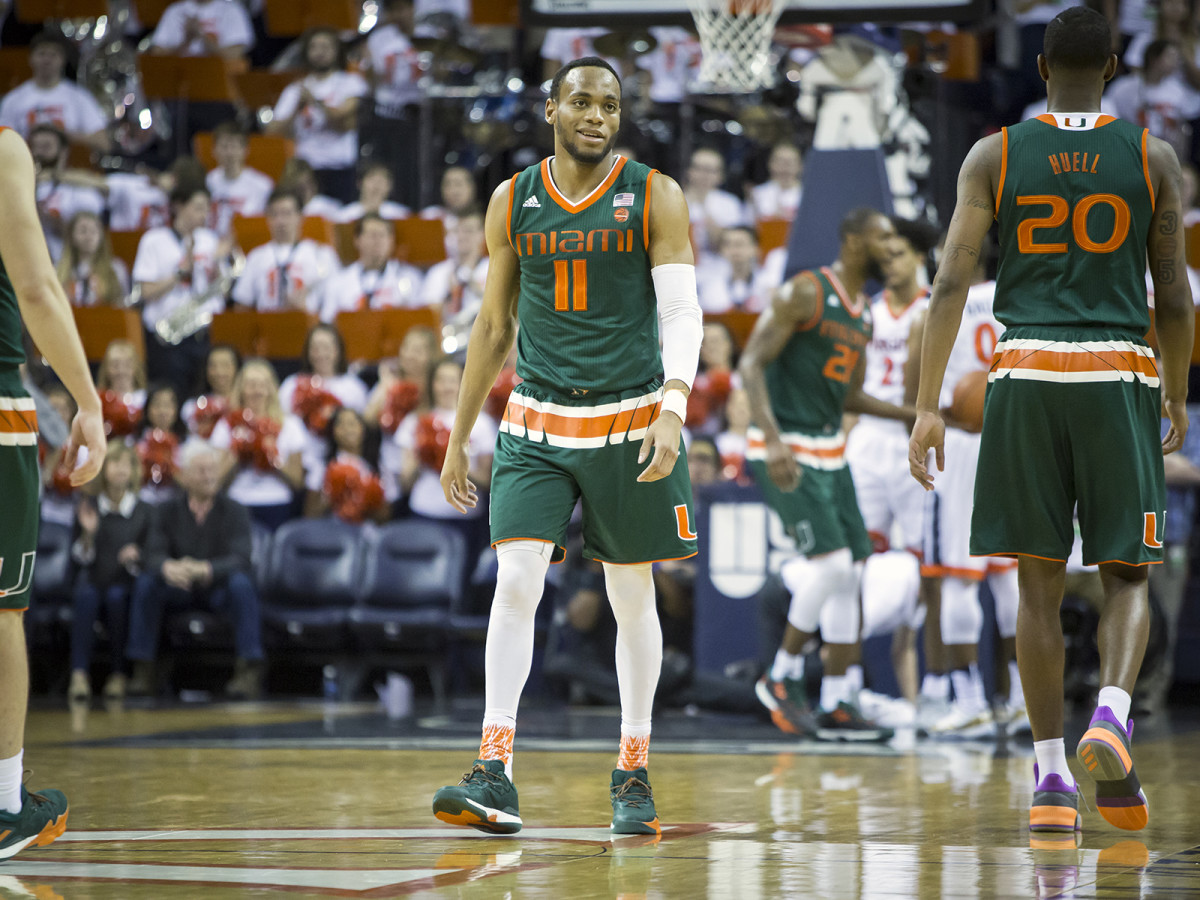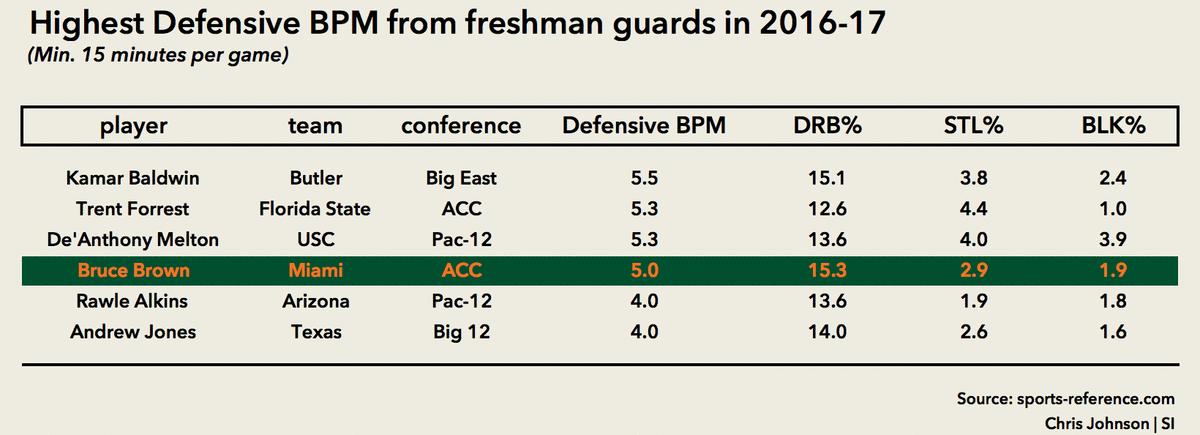Bruce Brown's Return To Miami Could Pay Off in NBA Draft

The upper crust of the 2018 NBA draft class skews large. In a stark reversal from the ’17 class, which saw eight point guards or shooting guards fly off the board over the first 13 picks, only two guards are projected to be selected in the top 10 of Sports Illustrated’s latest ’18 mock draft, and four of the best five players on the big board we’re releasing this week are forwards or centers. The absence of backcourt players in that range reflects a lack of star power at those positions, but that shouldn’t be confused for a dearth of quality. There are PGs and SGs who should provide starter-at-minimum value in this draft, and one of them is Bruce Brown.
Brown didn’t attract a lot of national attention as a freshman at Miami last season, mostly because the Hurricanes were just OK: They won only 21 games, finished tied for seventh place in the Atlantic Coast Conference and settled for a No. 8 seed in the NCAA tournament before being bounced by Michigan State in the opening round. When ESPN reported in early April that Brown would be back for his sophomore season, it barely registered on the college hoops news radar. The muted response felt appropriate given his relatively low profile at a football school overshadowed by hoops-first powerhouses in the same league.
2018 NBA Mock Draft: First-Round Projections
Had Brown decided to enter the draft, there seems a decent shot some team would have nabbed him late in the first or early in the second round. But after talking to people close to him—including Leo Papile, the founder of Brown’s grassroots program, Boston Amateur Basketball Club (BABC), and a former front office executive for the Boston Celtics with contacts around the NBA—Brown reached the conclusion that he wasn’t ready to make the jump. During the one-and-done era, staying in school has increasingly become the disfavored option among players with even a small glimmer of pro potential, but it could pay off for Brown in a big way.
Brown is one of the few high-end prospects at a position of scarcity in this class. That’s not totally accurate, because he’s capable of lining up at both point guard and shooting guard, a malleability that raises his floor and increase his utility in different lineups. Brown, who turned 21 in August, is older than every other college sophomore who’s currently considered a prospective candidate to be drafted next summer. Though age may limit his developmental upside, Brown can counteract that knock during a 2017–18 season that should see him evolve from a promising newcomer on a middling team to the alpha dog of a legit national championship contender.
When you watch Brown, the first thing that sticks out is his body. His musclebound 6’5,’’ 190-pound frame (6’9’’ wingspan) seems like a better fit for a free safety than a floor general, so it’s no wonder that he played both football and basketball before transferring to a high school that dropped the former. Brown has the physical tools to check every perimeter position, and he can hold up physically if 4s or 5s try to bully him around the basket. “If a big guy tried to post him up, he wouldn’t lose a pushing contest,” Papile recalls of Brown’s time with the BABC. “Because of that football savvy and strength.”

It’s not inconceivable that, depending on the matchup, Brown could be used in a similar manner to how the Boston Celtics sometimes stick 6’4’’ guard Marcus Smart on big men. Even if Brown will be spending almost all of his time guarding 1–3, his defensive range is a huge asset in a league that increasingly prizes the ability to switch assignments and that continues to push the boundaries of front court downsizing. (P.J. Tucker can play center now!) Brown is active when guarding on the ball, if somewhat inconsistent away from it, and he brings the added defensive benefit of limiting second-chance opportunities by snatching rebounds.
There were only three freshman guards who averaged at least 15 minutes per game last season that posted a higher Defensive Box Plus/Minus—a statistic that measures contributions on that end of the court, like blocks and steals—than Brown: Butler’s Kamar Baldwin, Florida State’s Trent Forrest and Southern California’s De’Anthony Melton.

Brown has an opportunity to assert himself as Miami’s go-to perimeter defender this season. The Hurricanes are stocked with capable backcourt scorers like senior Ja’Quan Newton and fellow freshmen Lonnie Walker and Chris Lykes, but they’ll need a lockdown artist in bouts with ACC competitors like Duke and North Carolina. Miami is losing 6’6’’ wing Davon Reed, an all-league defensive honoree selected with the No. 32 pick in the ’17 draft. “The guy who is most similar to Davon athletically—size, length, jumping ability—is Bruce,” Miami head coach Jim Larrañaga says. “With that in mind, we’re going to be pushing him to become a stopper.”
One of the factors that drew Brown to Miami is its ball screen-heavy, pro-style offense. As a five-star recruit from Boston, he was known more as a physical slasher than a savvy offensive initiator, but Larrañaga didn’t hesitate to put him in the driver’s seat on pick and rolls last season. According to data from Synergy Sports Technology, serving as the ball handler in P&Rs was Brown’s most frequent play type. He wasn’t great in those situations, averaging only 0.74 points per possession and turning the ball over 21.2% of the time. But Brown says he spent part of the offseason working on different pick and roll actions, and as a sophomore he’ll get more chances to show he’s a better playmaker than his grassroots rep implied.
NBA Draft Dispatch: The Five-Man Race for No. 1
Defenders can’t leave Brown alone behind the three-point arc. He connected on 33 of his 95 long-range tries last season (34.7%); sank 26 of his 61 (42.6%) catch-and-shoot jumpers, per Synergy, and he can blow by weak closeouts. But Brown will need to develop as an off-the-dribble launcher to reach his ceiling as a pick-and-roll practitioner. If he doesn’t, coaches will be all too eager to encourage going under screens on Brown, comforted by the fact that he won’t pick up his dribble to let fly. On the 34 off-the-dribble Js Synergy logged for Brown in 2016–17, he scored only 11 total points.
Most coveted draft prospects, including Brown, need to work on their jumpers before they get to the league, but he can mitigate any early shooting woes with his ability to rush past defenders off the dribble. Brown is an armored sedan attacking the basket, rarely flinching at the point of contact and exploding through channels of space. Watch him split a pair of Florida State players by the three-point arc and burst into the lane before rising for a one-handed layup:
The trait that distinguishes Brown from other guards in this draft is not quantifiable. Before Brown blossomed into a top-30 high school recruit and a projected first-round pick, he needed to buy into Papile’s ethos at the BABC. “We look for two things,” Papile says. “Brains and balls.” There’s a doggedness to Brown’s game that’s seldom seen in players his age. He’s a rugged, high-energy competitor who punishes players loafing through possessions and falls into the category of what Papile describes as “guys that don’t fool around.” You probably didn’t need to read this entire sentence to identify the player Brown watches highlights of “non-stop”: Russell Westbrook.
NBA Power Rankings: Melo-Less Knicks Surge Past Thunder
Brown is often listed as a shooting guard, but Larrañaga is convinced otherwise: “Bruce is going to be an NBA point guard,” he says. Newton started at the 1 for Miami last season, but Brown will be charged with running the offense at times as a sophomore, on what Larrañaga describes as “very much a perimeter-oriented team” that’ll also have another possible first-rounder threatening opposing defenses in Walker. Although media members voted Duke first in the ACC’s preseason poll last month, Miami could be its prime challenger. (SI projects the Hurricanes as the conference’s No. 3 team.) Against the Blue Devils, Brown will have an opportunity to upstage one of the only backcourt prospects showing up ahead of him in early ’18 mocks: PG Trevon Duval.
Even that individual matchup, though, would get second billing in a game featuring a candidate for the No. 1 overall selection in the draft, Duke freshman Marvin Bagley III. NBA-inclined observers tuning in to catch a look at the next potential unicorn big should get familiar with the relentless guard on the other team.
